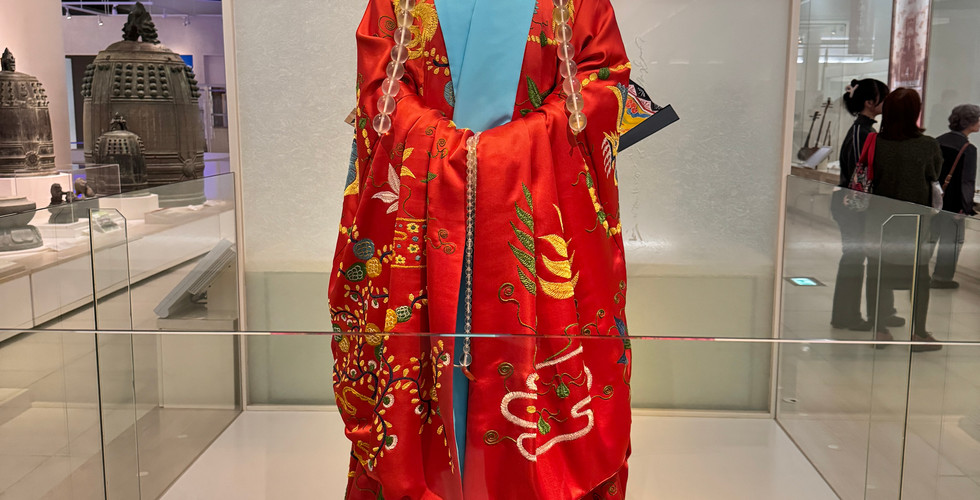Journey to Okinawa—Okinawa Prefectural Museum, Art Museum and Glassmaking
- Cathy Shen

- Sep 19
- 5 min read
In February 2025, I paid a trip to Okinawa, Japan. This journey offered both laughter and inspiration. Okinawa, Japan's tropical paradise, showcased its stunning coastlines and pristine waters, which profoundly influenced its history, cuisine, and way of life. As the heart of the ancient Ryukyu Kingdom, Okinawa exemplifies a rich cultural heritage that blends Chinese, Japanese, and Southeast Asian influences, evident in its architecture, traditions, and festivals. Its cuisine reflects this fusion, featuring fresh seafood like sashimi, as well as local delicacies such as Okinawan wagyu beef, which emphasizes the islands’ connection to both land and sea. Finally, our everyday conversations with the Okinawan people revealed their warmth and resilience. The Okinawan people were extraordinarily hospitable and helpful, making us feel both accepted and respected as foreigners in this land of unforgettable experiences.

The Coast
The fourth day of our journey came as we decided to look into Okinawa’s history and culture instead of letting our trip be immersed in the simple, shallow admiration of landscapes only. The Okinawa Prefectural Museum and Art Museum, affectionately known as "Okimu," located in the Omoromachi district of Naha City, caught my attention.
The museum’s exhibitions were divided into diverse sections. The Natural History section featured coral reef-inspired exhibits, specimens of flora and fauna, and even artifacts like the Minatogawa Man, the oldest Homo sapiens remains in East Asia. The History section detailed Okinawa’s unique past, from the rise and fall of the Ryukyu Kingdom to its annexation by Japan, the American occupation, and its return to Japanese sovereignty in 1972. Among all, I was most interested in the art exhibits, which focused on modern and contemporary artworks by Okinawans as well as some ancient artworks and calligraphy.
The museum included some works sent to Okinawa by the Chinese. I could sense an overwhelming familiarity at the sight of these masterpieces, since I’ve been learning Chinese traditional painting for ten years. One piece of artwork that left me with a strong impression was a scroll painting of Messenger to Ryuku from China in the 18th century, which was during the Qing Dynasty. The painting was meant to record the entitlement of Shuri City, considering that Okinawa was once a vassal state committed to the Qing Dynasty. I observed the details and brushstrokes carefully. Mountains and architecture were depicted with extreme care, seen through the thin yet smoothly drawn lines, which must be from a man of exceptionally qualified skills that granted him with such unwavering determination as well as advanced techniques. I could see the soldiers behind the wall and the celebration of entitlement in the center of the city. The overall tone was harmonious yet modest, as the hue was far from ostentatious, with several tinges of teal-saturated hills emerging from behind the city, and tangerine sections were lightly embedded. Although the picture appeared to be viewed from a distance, it still vividly showcased the convivial atmosphere.
As I walked more into the exhibition, I found a painting, created by local Okinawans, that showcased the unique outlooks of ships in Okinawa. The typical red and black ship of Okinawa, often resembling the traditional tribute ships used during the Ryukyu Kingdom’s maritime trading era, featured a design heavily influenced by the styles of Chinese junks. There was a minimized model of the ship in the museum right beside the painting. I listened to the explanation given by the audio and did some research myself: These ships were large, with curved hulls that allowed for better navigation in the choppy waters around Okinawa and the East China Sea. The black portions of the ship, usually painted along the hull, highlighted its sleek, sturdy structure, while the red accents, often prominently displayed on the masts, sails, and decorative elements, reflected the vibrant cultural aesthetics of the Ryukyu Kingdom.
This ancient Okinawan painting shared numerous similarities with Chinese traditional painting. The brushstrokes as well as the texture of the paper were all alike, just as the Okinawan ship shared similarities with Chinese ships due to trade and the region’s historical tributary relationship with the Ming and Qing Dynasties. However, a major difference I noticed was that ancient Okinawan paintings generally used brighter and highly saturated hues such as bright red and sky blue. The range of colors used was wider, unlike Chinese paintings in which many spaces were left blank and the ink contours were seldomly colored. Coming to the details of the painting, I found that Okinawans were quite strict with their color choices, as the hue of the ships on the painting exactly resembled the hue of the real model, even when thousands of years had passed after the initial creation of the artwork. The artist employed a diverse spectrum of reds, a color commonly associated with luck in Asian culture. Moreover, curls of waves were also portrayed as whirling at the bottom of the ships, and this made me correlate it with the fascinating ocean I saw the day before. In the end, I came to the conclusion that this masterpiece absolutely exemplified the unique culture of Okinawa, which remained distinct from mainland Japan and would continue to shine on the grand tapestry of human civilizations.
Afterwards, I moved to the clothes section. The museum exhibited several typical garments of ancient Okinawa. I observed them and listened to the audio. The main traditional garment is called the Ryūsō, which bears similarities to the Japanese kimono but has significant differences that reflect Okinawan culture. I took a closer look at the models, and it occurred to me that the Ryūsō seemed to be somehow looser-fitting. A soft belt was located at waist-high level, though the way it was tied was quite different from mainland Japanese styles I saw before. FIn historical times, commoners typically wore simpler materials like hemp or cotton for everyday clothing, while silk was reserved for more formal or ceremonial occasions. Nobles adorned Ryūsō with elaborate designs and luxurious fabrics to indicate their status.
Furthermore, another distinguishing feature I noticed was that Okinawan traditional clothes were made with lighter, breathable fabrics, either to suit Okinawa’s subtropical climate or to correspond with their lightly colored artworks. I tend to believe that these vivid colors reflected the island's tropical environment: blue and green tones are inspired by the surrounding seas and lush flora, while reds, oranges, and yellows evoke the coral reefs, sunsets, and Okinawa’s energetic atmosphere. Purple, historically a color of royalty in the Ryūkyū Kingdom, was primarily worn by the aristocracy. The lively and celebratory feel these colors evoked reminded me of the joyful spirit of Okinawan culture.
While scanning through the shops in our hotel and along the streets, one thing that was particularly noticeable was the Okinawa glassmaking artworks. Almost every bracelet or necklace was made with glass in Okinawa, and their illustrious hue made me decide to look into their specialty.
Historically, the Okinawan glass tradition, known as Ryukyu glass, originated during the Ryukyu Kingdom era (1429–1879). However, modern Ryukyu glassmaking saw a revival following World War II. After the war, resources like scrap glass from American military bases were repurposed by Okinawan artisans, reflecting the resilience and creativity of the local people.
Speaking of the different hues, I found that the most striking color was navy blue, and I bought such a bracelet myself. This color somehow evoked images of the limpid, deep waters of the Okinawan coast and the vastness of the Pacific Ocean. I could picture in my mind the cobalt blue skies and seas for which Okinawa is famous. Additionally, navy blue glass pieces capture and refract light beautifully (they glow in completely dark situations), giving them a radiant, sparkling quality. When light passes through, the glass can appear lighter or darker, reminiscent of how sunlight dances on the ocean’s surface. This quality, I suppose, makes navy blue glass especially valuable for decorative items like vases, tumblers, and ornaments I've seen in shops.







































Comments